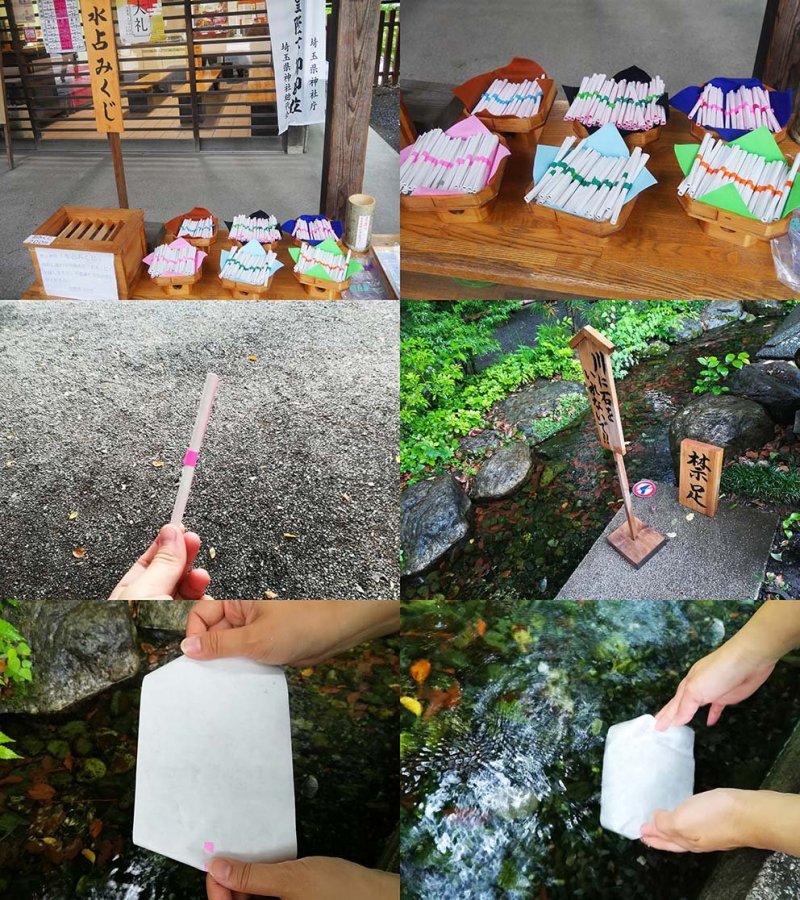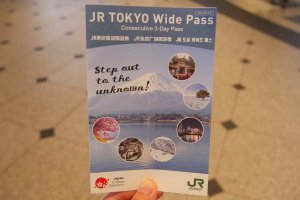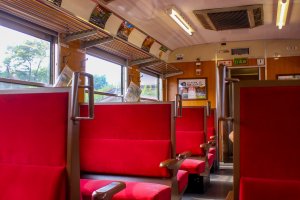The Northward Golden Route spans across Saitama, Gunma, and Niigata prefectures; and if you enjoy nature, history, and hot springs, you might want to consider this route as an interesting way to explore these prefectures near Tokyo. The beautiful scenery of Nagatoro, the delectable local sake and food of Chichibu, the vintage atmosphere of “Little Edo” in Kawagoe, Saitama, is easily accessible from Tokyo. In this feature, we introduce a model course in Saitama for you to enjoy three fun-filled days.
With excellent railway access from Tokyo, we take you through the minutiae of what you can cover using the JR TOKYO Wide Pass in Saitama.
The JR TOKYO Wide Pass allows non-Japanese passport holders to travel on JR trains (including shinkansen and limited express trains) and selected non-JR trains in the Kanto Region for three consecutive days. You can check fares and different train routes of the JR TOKYO Wide Pass here.
Day 1

We went to the JR EAST Travel Service Center after arriving at Tokyo Station to buy our passes. It is just next to the Marunouchi North Gate of Tokyo Station.
The staff at the JR EAST Travel Service Center speaks English and is very friendly, so don't hesitate to ask them about the train routes and passes you may use while traveling the Northward Golden Route.
You can also get information on sightseeing spots, restaurants, and shops in Japan. Tourism booklets and pamphlets are available for free.

We got our passes sorted and booked reserved-seat tickets for the Jōetsu Shinkansen (Toki 309) bound for Kumagaya Station. You can also book your reserved-seat tickets for the Jōetsu Shinkansen using the JR TOKYO Wide Pass and collect your tickets at the JR EAST Travel Service Center. Visit JR-EAST Train Reservation to book your reserved-seat tickets online.

Kumagaya is just 40 minutes from Tokyo Station. Here we transferred to the Chichibu Railway to take the Paleo Express, the closest running steam train to Tokyo. This train is not covered by the JR TOKYO Wide Pass, so you need to purchase a Paleo Express ticket separately.

The Paleo Express generally only runs on weekends and public holidays, except during the summer and fall holidays, when it also runs on weekdays. You can check the train schedule here.

The Paleo Express offers unreserved and reserved seats. We purchased reserved seats for our trip to Nagatoro. You can enjoy the vintage atmosphere offered by this retro train.
It took about an hour and a half to reach Nagatoro from Kumagaya Station. Nagatoro is a small but scenic town in western Saitama and it’s a popular spot for nature lovers looking for hiking, riverboat tours, and wild water sports.

We decided to try Nagatoro River Boating, so we left our luggage and picked up some English brochures at the Nagatoro Tourist Information Hall, which is right across the exit of Nagatoro Station on the Chichibu Railway.

We purchased our tickets at the Nagatoro White Water Rafting Sales Office. There are three choices: route A (Oyahana Course), route B (Takasago Course), and route A+B (Iwadatami course). We chose route B—a course bound for Takasago Bridge.

We traveled downriver in a traditional Japanese boat. The boat took us down the river slowly with gorgeous sights of lush green scenery and rock terraces.
The river flows fast in certain rocky areas, so you might get sprayed with water. Our boat skipped the extreme parts of this course because it was raining that day. It was an exhilarating experience. After we finished, we took a shuttle bus up to the sales office.
We were quite hungry after boating, so we decided to have lunch at Otofudokoro Umedaya, a famous tofu restaurant in Nagatoro.

Umedaya, within a ten-minute walk from Nagatoro Station, is located inside a kominka (Japanese traditional home). Tofu, also known as bean curd, is made from condensed soy milk pressed into solid white blocks. It is low in calories, rich in protein, and, of course, vegan friendly.

Umedaya offers tofu lunches made using additive-free tofu made from a native Chichibu soybean called Hakko and natural nigari (bittern). The menu varies seasonally. We ordered the Umedaya Tofu Lunch, consisting of eight different tofu dishes: Oboro tofu (silken tofu curd), takigawa tofu (jellied tofu strips) with sesame dressing, okara salad (soy pulp salad), marinated tofu, nanohana (rapeseed flowers) with white sesame and miso sauce, fresh yuba (tofu skin), and freshly squeezed soy milk. The lunch set comes with a bowl of multigrain rice and a cup of miso soup.

A sweets shop next to the restaurant offers sweets made from okara, soy pulp produced during tofu making. You can buy okara donuts (baked or fried), okara cookies, and okara pudding; we decided to try the plain okara fried donuts and loved them!
The donuts were soft, fluffy, and not overly sweet. Definitely perfect to snack on while sipping your favorite drinks!
- Map
- Official website (Japanese)

We took the train bound for Chichibu Station on the Chichibu Railway to visit Bukou Brewery (武甲酒造), a local brewery in Chichibu famous for its signature sake, Bukou Masamune, which has been awarded numerous prizes at various competitions and fairs.
Established as Yanagida Sohonten in 1753, Bukou Brewery uses Bukousan underground water—one of the 100 Exquisite and Well-Conserved Waters of the Heisei Period—as one of its main ingredients for the sake.
We participated in a brewery tour, available by reservation and free of charge. Since the tour is conducted in Japanese, you may have to bring someone who understands Japanese with you. The brewery tour will take you through the whole process of making sake (nihonshu).

It also includes a sake-tasting session called “kikizake”, where you can drink and compare several different types of nihonshu. After the sake tasting, you can explore the shop area and purchase unique sake, sake products, and miso paste (tax-free shopping available). The brewery is located within a five-minute walk from Chichibu Station on the Chichibu Railway.
- Map
- Official website (Japanese)

After enjoying the brewery tour, we walked to Chichibu Shrine—a Shinto shrine in central Chichibu—known as the home of the Chichibu Night Festival, which takes place in early December every year.
Said to be over 1,000 years old, its current buildings were built in 1592 by Tokugawa Ieyasu. The shrine is famous for its intricate wood carvings and unique omikuji called “mizu uranai.” Mizu literally means water, and omikuji are Japanese fortune-telling strips that are sold at shrines and temples throughout the country. Let’s find out what a mizu uranai is!

We found wooden boxes where the mizu uranai were sold and threw two 100-yen coins into the coin box. We picked a mizu uranai that had a light pink ribbon and went to the pond near the entrance. We dipped the mizu uranai into the water to read our fortune, and . . .

VOILA! We got the “suekichi” (末吉, late fortune), which means good luck will come to our life sometime soon. Not the best fortune but definitely better than getting one that says bad luck.
- Map
- Official website (Japanese)

We’d been walking since morning and it seemed like the right time for some TLC! Our final stop for the day was Matsuri-No-Yu in Chichibu. Opened in April 2017, Matsuri-No-Yu is a large two-story building offering various types of hot spring baths, spa services, relaxation spaces, and a shopping area featuring local specialties and a food court.

The hot spring baths at Matsuri-No-Yu are undoubtedly the main attraction of this facility, featuring five different indoor baths for men and six baths for women. Saunas and jacuzzis are also available.
The open-air baths are called “hanamiyu” (flower viewing baths), where guests can relax while enjoying the sights of seasonal flowers and sounds of nature. There are also rock baths and lie-down baths.

After enjoying the hot spring baths, we went to Chichibu Waraji Katsutei at the food court to try its savory waraji katsudon for dinner. Waraji are traditional Japanese sandals woven from straw, and katsudon is breaded, deep-fried pork cutlet on a bowl of rice. We ordered the original waraji katsudon, consisting of two slices of thin pork cutlet on one bowl of rice.
The pork cutlets used in waraji katsudon are very thin compared to the typical pork cutlets used in “tonkatsudon” (pork cutlet rice bowl) and they are dipped in a salty-sweet secret sauce. The pork cutlets are crispy yet tender. The portion is just right for dinner, enough to fill your belly until the next morning.
- Map
- Official website (Japanese)

We called it a day and stayed at Comfort Stay Miyabi, which is a ten-minute walk from Seibu-Chichibu Station. The rooms are spacious, clean, and equipped with comfy beds. The breakfast buffet is on another level, we recommend booking the bed & breakfast plan if you’re curious about the taste of Japanese home cooking.
Day 2
Continuing our Northward Golden Route journey with the JR TOKYO Wide Pass, we explored Kumagaya and Omiya known for its temples, museums, and shrines on the second day.

We left Comfort Stay Miyabi and arrived at Chichibu Station to take the train bound for Kumagaya Station on the Chichibu Railway. From there, we took the local bus departing from bus stop no. 6 of Kumagaya Station to visit the grand Menuma Shodenzan Temple. Menuma Shodenzan Temple is one of Japan’s three great Shoden temples, standing alongside Matsuchiyama Shoden (Tokyo) and Ikoma Shoden (Nara).

The highlight of this temple is its main hall, Kangiin Shodendo, which was designated a Japanese National Treasure. There is an admission fee for entering the main hall. You can check the fee on the official website.
After visiting the Menuma Shodenzan Temple, we headed to Ganso Kumagaya Udon Fukufuku for an early lunch.

We tried Fukufuku’s signature menu, “Nikujiru Udon,” thick Japanese wheat noodles served with a warm dipping soup. We also purchased ramune, a carbonated drink that originated in Japan and tastes like Sprite. What we loved most about Kumagaya udon is its chewy texture and savory dipping soup. Definitely worth a try while you’re in Saitama!
- Map
- Official website (Japanese)

We returned to Kumagaya Station by local bus and took the train bound for Omiya Station on the JR Takasaki line. At Omiya Station we transferred to the JR Utsunomiya line and took the train bound for Toro Station, the closest station to The Omiya Bonsai Art Museum.

Bonsai is the art of growing trees and shrubs in pots. You can see various types of bonsai art pieces at The Omiya Bonsai Art Museum, a mecca for bonsai lovers. Located within a five-minute walk from Toro Station, this museum opened in 2010, and is known as the world’s first public museum dedicated to bonsai art.
The museum prides itself on its great collection of more than 120 bonsai masterpieces and bonsai-related artifacts like bonsai pots, miniature landscape stones called suiseki, books, and woodblock prints (ukiyoe).

At this museum, you can learn more about bonsai’s deadwoods: jin (bare-stripped part of branch) and shari (barkless part of trunk). Don’t forget to check “Seiryu,” a dragon look-alike bonsai tree, an iconic symbol of this museum! English brochures are available at the ticket counter and all explanations of bonsai are written in English and Japanese.

Our next stop was the Musashi Ichinomiya Hikawa Shrine, the grand head shrine of the Hikawa shrines in the Kanto Region. The best way to reach this shrine from the museum is on foot (approximately 30 min). Said to be over 2,400 years old, this shrine is famous for hosting many traditional festivals including Toka-machi (10th Day Market) and Omiya Takigi Noh.
- Map
- Official website (Japanese)
The shrine was our final stop for the day and we took the train bound for Kawagoe Station on the JR Kawagoe line to go to Kawagoe Prince Hotel, our accommodation for the night.

We went to Musashino for dinner after we checked in to the hotel. Musashino, a Japanese restaurant located on the 2nd floor of Kawagoe Prince Hotel, offers guests an exquisite Japanese dining experience. We ordered the Hana Gozen dinner set for each of us, a cup of Kagamiyama Junmaishu, and a bottle of Coedo beer “Beniaka.” The Hana Gozen dinner set consisted of seven types of dishes that were served over several courses.

Three small portions of appetizers, sashimi salad, and simmered pork belly and vegetables were served first. This was followed by grilled fish served with fried or steamed dishes.

Three pieces of sushi and miso soup are served together before the dessert. Mizuyokan, a chilled Japanese red bean jelly, was served as the dessert of the day.

Kagamiyama Junmaishu is a nihonshu produced in Kawagoe. It’s very light and dry, a perfect nihonshu choice for everyone. The Coedo beer “Beniaka” is one of Kawagoe’s famous craft beers. Made from Saitama sweet potatoes, this beer is rich and smooth. After this delicious meal, we returned to our rooms and called it a day.

Staying at Kawagoe Prince Hotel was memorable. We were spoiled by its delectable Japanese cuisine, spacious rooms with comfortable beds, clean bathrooms with spacious bathtubs, and hearty breakfast.
Day 3
After spending two consecutive days exploring Chichibu, Kumagaya, and Omiya areas, we visited Kawagoe, also known as “Little Edo” on our last day. We checked out of the hotel and visited the Kawagoe City Tourism Information Center at Hon-Kawagoe Station on the Seibu Railway to get information on Kawagoe’s most popular sightseeing spots. There are also some English brochures available here.

We took the CO-EDO Loop Bus, a vintage front-cab bus offering transportation to Kawagoe’s sightseeing spots. Each bus stop is located within a one-minute walk from the sightseeing spot.

We got off at Kitain Temple that holds the last remains of Edo Castle. Kitain is said to be over 1,200 years old and it played a major role during the rule of the Tokugawa Shogunate. Kitain is believed to have magical powers to ward off evil and bad luck. Nowadays people visit the temple in order to pray for protection.

The temple turns to a popular cherry blossom viewing spot in spring.

Our next stop was Koedo Kurari, a place where you can find local Kawagoe products, eat local meals, and try various types of nihonshu from Saitama.

The highlight of Koedo Kurari was its Kikizake Dokoro Showagura, where you can try four types of nihonshu for just 500 yen (the price might change without prior notification). All you have to do is purchase the coins for the sake tasting vending machines.

There are four vending machines featuring standard nihonshu and limited edition nihonshu from Saitama (a complete nihonshu list is available in English). Insert one coin into the machine, set your cup inside the machine and press the button of the nihonshu you’d like to try. The machine will dispense the nihonshu into your cup.

If you haven’t bought anything for your family and friends back home, you can purchase the one cup sake or the mini-size nihonshu at the Omiyage Dokoro Meijigura, the souvenir shop in Koedo Kurari. You can also try some local food at Makanai Dokoro Taishogura, a restaurant and café in Koedo Kurari.
- Map
- Official website (Japanese)

We left Koedo Kurari and headed to Taisho roman Street, an area in Kawagoe lined with many Edo Era (1603-1868) buildings.

We continued walking to Kawagoe’s Warehouse District (蔵造りの町並み, Kurazukuri no Machinami) that is lined with clay-walled, warehouse-styled buildings.

Our next destination was Toki no Kane, a bell tower located in the middle of the warehouse district. It was once destroyed by a fire in 1893 but soon rebuilt. Today, the bell tower is considered to be the symbol of Kawagoe and the bell rings four times a day (6:00, 12:00, 15:00, and 18:00).

We then walked to Candy Alley (菓子屋横丁, Kashiya Yokocho), a small shopping district lined with stores selling traditional Japanese sweets and cakes, which gave the alley its name. You can find various types of traditional Japanese sweets and snacks throughout the alley, including candies, rice crackers, karinto (sugar-coated, deep-fried cookies), etc. You can also purchase traditional Japanese toys and souvenirs here.

Our final stop for this route was Torocco, a famous café in Kawagoe serving sweet potato mini-kaiseki (Japanese multi-course lunch featuring sweet potato). The sweet potato mini-kaiseki consisted of eight sweet potato dishes: sweet potato croquette, shrimp gratin with creamy sweet potato sauce, simmered deep-fried tofu and imogara, sweet potato with white miso and sesame sauce, agedashi sweet potato mochi, sticky rice with sweet potato, sweet potato miso soup, and sweet potato ice cream.

The sweet potato mini-kaiseki lunch was unforgettable and excellent value for money. We really loved the cozy atmosphere of this café.
You might have not considered some of these lesser-known spots in your itinerary for Japan. How about exploring Saitama prefecture on the Northward Golden Route of Japan?
This is the first part of a series about traveling along the Northward Golden Route covering Saitama, Niigata, and Gunma prefectures. If you want to see more photos of this amazing trip, do check the photo gallery on the right.
.article p img { width: 23%; margin: 1em auto; display: inline; text-align: center; margin-left: 23%; } img.img-responsive.text-center.xs { max-width: 4em; }

































